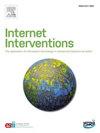数字心理健康干预用户的治疗联盟是否有其独特之处?使用电子健康治疗联盟量表进行研究
IF 4.1
2区 医学
Q1 HEALTH CARE SCIENCES & SERVICES
Internet Interventions-The Application of Information Technology in Mental and Behavioural Health
Pub Date : 2024-10-28
DOI:10.1016/j.invent.2024.100783
引用次数: 0
摘要
治疗联盟(TA)是传统心理疗法中预测临床疗效的一个行之有效的指标。然而,在电子健康干预中,治疗联盟与疗效之间的关系并不一致,这可能是由于缺乏专门用于捕捉电子健康环境中治疗联盟的测量指标。电子健康治疗联盟量表(ETAI)包含了传统的和独特的电子健康治疗联盟分量表,从而能够检验传统概念之外的新的治疗联盟方面的贡献。本研究调查了与传统 TA 子量表相比,电子健康 TA 子量表对临床结果的预测贡献,并评估了 ETAI 的并行标准有效性。这项研究是在随机对照试验框架内进行的,该试验涉及一项为期 10 周的数字家长培训计划,旨在解决儿童的干扰行为。家长们被随机分配到增强质量或标准质量的项目中。来自 68 个家庭的家长在项目启动后 5 周和干预后阶段完成了 ETAI。主要结果是儿童行为的改善,采用艾伯格儿童行为量表进行测量。在 5 周时间点测量的涵盖电子健康 TA 独特方面的所有 ETAI 分量表与干预后儿童行为改善之间均存在正的皮尔逊相关性(rs ≥ 0.23, ps < 0.03)。常规 TA 分量表与儿童行为的改善没有明显的皮尔逊相关性。在研究 ETAI 子量表对解释儿童行为改善的独特贡献时,发现只有 ETAI-感知情感投资子量表具有独特贡献(β = 0.29,P = 0.019)。此外,与标准项目相比,大多数 ETAI 子量表的得分在使用增强质量项目的家长中明显更高(Cohen's ds > 0.48),这加强了 ETAI 的标准效度。结合独特的电子健康 TA 子量表开发的 TA 量表在预测结果方面初见成效。要更好地了解电子健康 TA 的不同因素与不同临床目标和项目的临床结果之间的关系,还需要进一步的研究。本文章由计算机程序翻译,如有差异,请以英文原文为准。
Are there unique facets of therapeutic alliance for users of digital mental health interventions? An examination with the eHealth Therapeutic Alliance Inventory
Therapeutic alliance (TA) is a well-established predictor of clinical outcomes in traditional psychotherapy. However, its association with outcomes in eHealth interventions has been inconsistent, which might be due to the absence of measurements specifically designed to capture TA in eHealth settings. The eHealth Therapeutic Alliance Inventory (ETAI) incorporates conventional as well as unique eHealth TA subscales, enabling to examine the contribution of new facets of TA beyond traditional concepts. This study investigates the predictive contribution of eHealth TA subscales compared to conventional TA subscales on clinical outcomes and evaluates the concurrent criterion validity of the ETAI. The study was conducted within the framework of a randomized controlled trial involving a 10-week digital parent training program aimed at addressing child disruptive behaviors. Parents were randomly assigned to either an enhanced-quality or a standard-quality program. Parents from 68 families completed the ETAI at five weeks' post-program initiation and at the post-intervention phase. The primary outcome was the improvement in child behavior, measured by the Eyberg Child Behavior Inventory. Positive Pearson correlations were found between all ETAI subscales covering unique eHealth TA aspects, measured at the 5-week time-point, and improvement in child behavior at post-intervention (rs ≥ 0.23, ps < 0.03). The conventional TA subscale showed no significant Pearson correlation with improvement in child behavior. When examining the unique contributions of ETAI-subscales to explain the improvement in child behavior, only ETAI-Perceived Emotional Investment subscale was found to have a unique contribution (β = 0.29, p = 0.019). In addition, scores on most ETAI subscales were significantly higher among parents using the enhanced-quality program compared with the standard program (Cohen's ds > 0.48), reinforcing ETAI's criterion validity. The development of TA scales that incorporates unique eHealth TA subscales show initial promise in predicting outcomes. Further research is needed to better understand how different factors of eHealth TA relate to clinical outcomes across diverse clinical targets and programs.
求助全文
通过发布文献求助,成功后即可免费获取论文全文。
去求助
来源期刊

Internet Interventions-The Application of Information Technology in Mental and Behavioural Health
Medicine-Health Informatics
CiteScore
6.50
自引率
9.30%
发文量
94
审稿时长
6 weeks
期刊介绍:
Official Journal of the European Society for Research on Internet Interventions (ESRII) and the International Society for Research on Internet Interventions (ISRII).
The aim of Internet Interventions is to publish scientific, peer-reviewed, high-impact research on Internet interventions and related areas.
Internet Interventions welcomes papers on the following subjects:
• Intervention studies targeting the promotion of mental health and featuring the Internet and/or technologies using the Internet as an underlying technology, e.g. computers, smartphone devices, tablets, sensors
• Implementation and dissemination of Internet interventions
• Integration of Internet interventions into existing systems of care
• Descriptions of development and deployment infrastructures
• Internet intervention methodology and theory papers
• Internet-based epidemiology
• Descriptions of new Internet-based technologies and experiments with clinical applications
• Economics of internet interventions (cost-effectiveness)
• Health care policy and Internet interventions
• The role of culture in Internet intervention
• Internet psychometrics
• Ethical issues pertaining to Internet interventions and measurements
• Human-computer interaction and usability research with clinical implications
• Systematic reviews and meta-analysis on Internet interventions
 求助内容:
求助内容: 应助结果提醒方式:
应助结果提醒方式:


